Taiwan has been fought over multiple times. The course of its history has been determined by the prowess or weakness of competing navies. The Dutch, who were world-class seafarers, were unchallenged when they landed at what’s now Anping District (安平) in Tainan in 1624. However, they couldn’t protect their colony when Cheng Cheng-kung (鄭成功, also known as Koxinga) led his band of Ming Dynasty loyalists to Taiwan in 1661.
At the start of the First Sino-Japanese War (1894-95), Tokyo was fearful of the Qing Empire’s Beiyang Fleet, in particular its two German-built battleships. The Qing warships turned out to be poorly maintained and incompetently commanded, and what remained of the Beiyang Fleet could do nothing when, a month before the end of the war, the Japanese occupied the Penghu Islands in preparation for taking control of Taiwan.
1661 WARSHIP MUSEUM
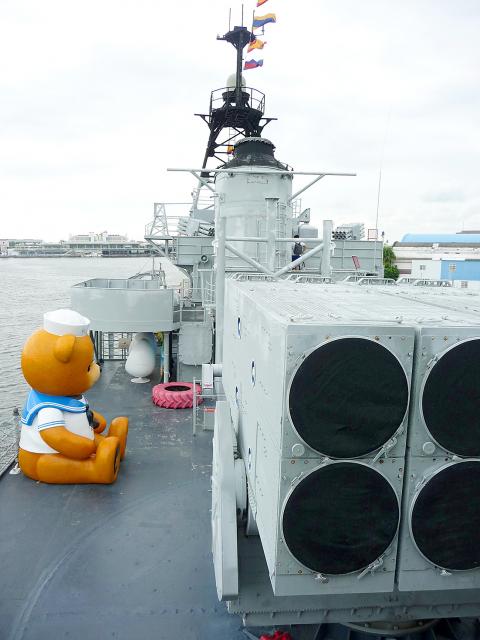
Photo: Steven Crook
The nautical aspect of Koxinga’s victory over the Dutch East India Company is celebrated in Tainan’s 1661 Taiwan Warship Museum (1661 臺灣船園區). You won’t learn anything about the man himself, or the reasons why he invaded Taiwan, but you’ll get a good idea of how his army crossed the Taiwan Strait.
The only exhibit is a 30m-long ship called the Taiwan Cheng-Kung Hao (臺灣成功號). It’s not a relic of Koxinga’s era, nor can it properly be called a replica. Building began in 2009, using blueprints preserved in Matsura Historical Museum in Nagasaki, Japan. Construction was paid for by Tainan City Government.
The ship’s maiden voyage took place in December 2010, and there were plans to sail it all the way around Taiwan, then onto Hirado (平戸市), the city in Nagasaki Prefecture where Koxinga was born in 1624. It was also expected to call at Penghu, Kinmen and Quanzhou (泉州) in China’s Fujian Province. However, this grand tour was curtailed after the ship’s 28m-tall mast broke. Replacing the mast was a major part of the 2015-16 restoration that preceded its installation on dry land.
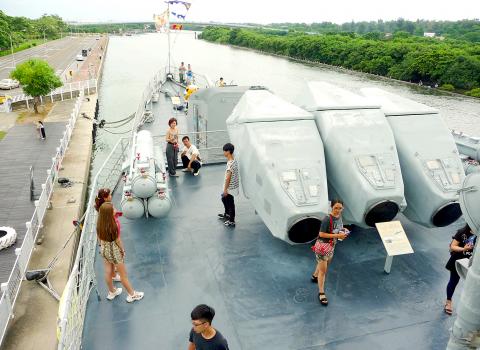
Photo: Steven Crook
Unlike the sail-and-oar powered vessels of the 17th century, the Taiwan Cheng-Kung Hao has engines and two brass propellers. In other respects, however, it’s thoroughly traditional. For instance, gaps between planks were sealed with a mix of Tung tree oil and powdered oyster shells. But seeing the cracks in the hull, some of them wider than a paperback novel, I wondered about the durability of this material.
On the ship, bilingual text present some interesting information: why the shipbuilders selected certain types of wood for different parts of the vessel. With a total weight of around 150 tonnes, it’s a tiddler by 21st century standards. Unfortunately, nowhere in the museum does it say how many men, in the era of sail, were needed to crew this kind of ship.
The museum is several hundred meters south of the historic heart of Anping at 139 Anyi Road (安億路). It’s open from 10am to 6pm Tuesday to Friday, and 10am to 8:30pm Saturday and Sunday. Admission is NT$50, but students, Tainan residents and some other categories of people get in for half price.
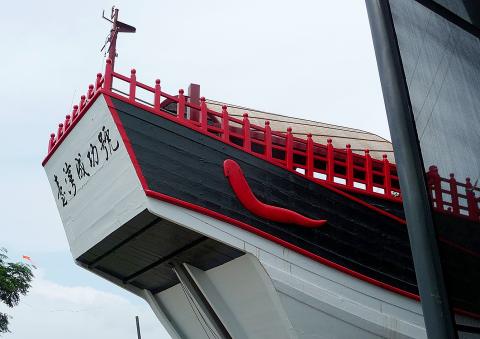
Photo: Steven Crook
The museum’s souvenir shop sells some items which you won’t see outside Tainan, such as Cheng Gong Potato Chips. These bear a likeness of Koxinga, and come in two flavors: salty and mango. The museum’s bilingual Web site is at taiwanwarship.tainan.gov.tw.
THE NAVY DESTROYER MUSEUM
If you walk south past a couple of small boatyards, you’ll come to the other warship that’s displayed in Tainan. The Navy Destroyer Museum (安平定情碼頭德陽艦園區) preserves a vessel that served in both the US and Taiwan navies.
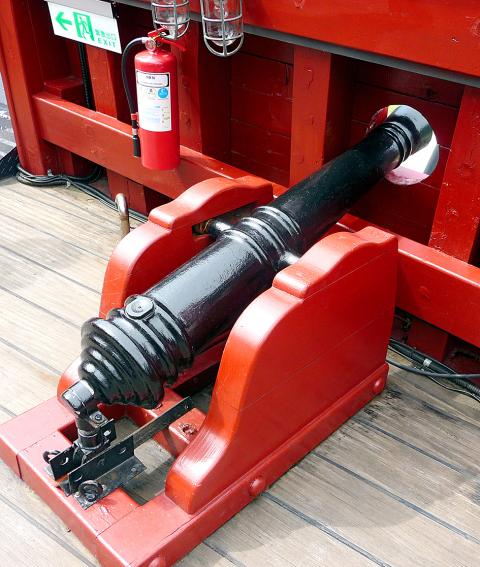
Photo: Steven Crook
The ship that began its long career as the USS Sarsfield was commissioned in Boston just a few weeks before the end of World War II. It was named after Eugene Sarsfield, who had gone down with the ship he was commanding, USS Maddox, two years earlier. The ship displaces 3,516 tonnes, is slightly over 119m long, and required a crew of around 360, the precise number fluctuating as systems were added or automated.
Over the following three decades, the destroyer criss-crossed the world. In 1977, it was transferred to Taiwan, renamed Te Yang (德陽) and given the designation DDG-925. Te Yang is the only survivor of the five Gearing-class vessels that joined Taiwan’s navy. Two were sunk as artificial reefs; another two have been broken up.
After 28 years of service in the seas around Taiwan, it was decommissioned at Kaohsiung. Four years later it was moved to Anping. After two years of preparation, it was opened to the public.
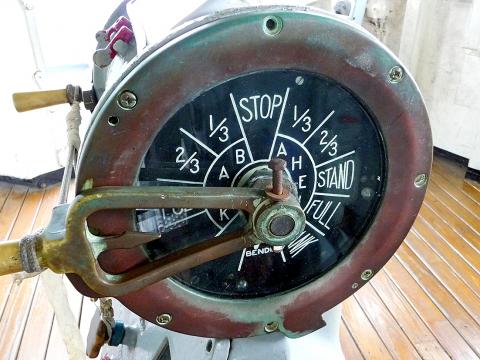
Photo: Steven Crook
Currently, almost every part of the vessel above the waterline is open to visitors. The frames of the major weapons systems — among them the five-inch forward gun, the Hsiung Feng I anti-ship missile launcher, the depth-charge release rack and the anti-submarine rocket launcher — have been left in place.
If you’ve an interest in military history, this is all pretty interesting and conventional. You might struggle, however, to see the relevance of the fiberglass teddy bears which dot the ship. They certainly add color, but I wasn’t able to grasp why they’re here.
Unfortunately, visitors don’t get much of an idea of what it was like to serve on Te Yang. The men onboard wouldn’t have had much privacy. Seeing how and where they slept, ate and showered would make this unusual museum more worthwhile.
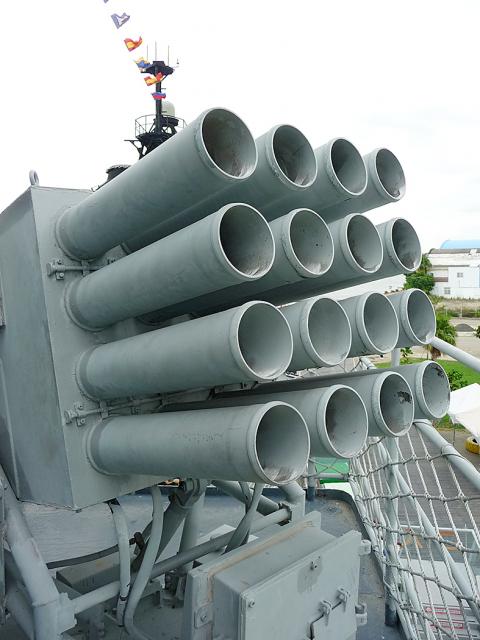
Photo: Steven Crook
The Navy Destroyer Museum is at 115 Anyi Road. It’s open every day from 9am to 6pm, and admission is NT$80. Tainan residents, students, and senior citizens pay NT$70. If you just want to view the outside of the ship from the dock, there’s no need to buy a ticket. The museum’s Web site, www.teyang925.com.tw, is in Chinese only.
Steven Crook has been writing about travel, culture, and business in Taiwan since 1996. He is the co-author of A Culinary History of Taipei: Beyond Pork and Ponlai, and author of Taiwan: The Bradt Travel Guide, the third edition of which has just been published.

May 26 to June 1 When the Qing Dynasty first took control over many parts of Taiwan in 1684, it roughly continued the Kingdom of Tungning’s administrative borders (see below), setting up one prefecture and three counties. The actual area of control covered today’s Chiayi, Tainan and Kaohsiung. The administrative center was in Taiwan Prefecture, in today’s Tainan. But as Han settlement expanded and due to rebellions and other international incidents, the administrative units became more complex. By the time Taiwan became a province of the Qing in 1887, there were three prefectures, eleven counties, three subprefectures and one directly-administered prefecture, with

It’s an enormous dome of colorful glass, something between the Sistine Chapel and a Marc Chagall fresco. And yet, it’s just a subway station. Formosa Boulevard is the heart of Kaohsiung’s mass transit system. In metro terms, it’s modest: the only transfer station in a network with just two lines. But it’s a landmark nonetheless: a civic space that serves as much more than a point of transit. On a hot Sunday, the corridors and vast halls are filled with a market selling everything from second-hand clothes to toys and house decorations. It’s just one of the many events the station hosts,

Among Thailand’s Chinese Nationalist Party (KMT) villages, a certain rivalry exists between Arunothai, the largest of these villages, and Mae Salong, which is currently the most prosperous. Historically, the rivalry stems from a split in KMT military factions in the early 1960s, which divided command and opium territories after Chiang Kai-shek (蔣介石) cut off open support in 1961 due to international pressure (see part two, “The KMT opium lords of the Golden Triangle,” on May 20). But today this rivalry manifests as a different kind of split, with Arunothai leading a pro-China faction and Mae Salong staunchly aligned to Taiwan.

Two moves show Taichung Mayor Lu Shiow-yen (盧秀燕) is gunning for Chinese Nationalist Party (KMT) party chair and the 2028 presidential election. Technically, these are not yet “officially” official, but by the rules of Taiwan politics, she is now on the dance floor. Earlier this month Lu confirmed in an interview in Japan’s Nikkei that she was considering running for KMT chair. This is not new news, but according to reports from her camp she previously was still considering the case for and against running. By choosing a respected, international news outlet, she declared it to the world. While the outside world